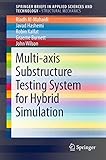Multi-axis Substructure Testing System for Hybrid Simulation [electronic resource] / by Riadh Al-Mahaidi, M. Javad Hashemi, Robin Kalfat, Graeme Burnett, John Wilson.
By: Al-Mahaidi, Riadh [author.] .
.
Contributor(s): Hashemi, M. Javad [author.] | Kalfat, Robin [author.]
| Kalfat, Robin [author.] | Burnett, Graeme [author.]
| Burnett, Graeme [author.] | Wilson, John [author.]
| Wilson, John [author.] | SpringerLink (Online service)
| SpringerLink (Online service) .
.
Material type:  BookSeries: SpringerBriefs in Structural Mechanics: Publisher: Singapore : Springer Nature Singapore : Imprint: Springer, 2018Edition: 1st ed. 2018.Description: XVII, 81 p. 57 illus., 45 illus. in color. online resource.Content type: text Media type: computer Carrier type: online resourceISBN: 9789811058677.Subject(s): Engineering geology
BookSeries: SpringerBriefs in Structural Mechanics: Publisher: Singapore : Springer Nature Singapore : Imprint: Springer, 2018Edition: 1st ed. 2018.Description: XVII, 81 p. 57 illus., 45 illus. in color. online resource.Content type: text Media type: computer Carrier type: online resourceISBN: 9789811058677.Subject(s): Engineering geologyIntroduction -- Background -- State-of-the-Art System for Hybrid Simulation -- Application of the MAST System for Collapse Experiments -- Closure.
This book describes the multi-axis substructure testing (MAST) system, a simulator developed at Swinburne University of Technology, Australia, which provides state-of-the-art technology for large-scale hybrid testing of structures under realistic scenarios depicting extreme events. The book also demonstrates the responses of physical specimens while they serve as part of the virtual computer model of the full structure subjected to extreme dynamic forces. Experimental studies using the MAST system are expected to enhance design and construction methods and significantly improve the repair and retrofitting of structures endangered by natural disasters and man-made hazards, providing a direct benefit to society by improving public safety and the re silience of the built environment. An additional benefit is increased sustainability in the form of reduced direct and indirect economic losses and social and environmental impacts in the face of extreme events. This book will be of interest to researchers and advanced practitioners in the fields of structural earthquake engineering, geotechnical earthquake engineering, engineering seismology, and experimental dynamics, including seismic qualification. .


There are no comments for this item.